 |
Communities - Pre-Railroad
Pre-Railroad Communities
Nelsonville & Mountain City
Glenora
Pilot Mound
Wakopa
Pembina Crossing
Clearwater, Neelin & Preston
Cartwright
Crystal City
|
Sometimes opportunity knocked and a pioneer responded. In the accounts passed down by the first settlers in Manitoba’s southwestern corner the name Nelsonville keeps popping up. It was a stop along their trek westward from Emerson. It was where they were able to buy their last supplies before heading into a land that didn’t yet have stores or other services. It sounds like it was an important place, but you won’t find it on any modern map. It is perhaps the best example of a Manitoba boom town. It is fitting that the first gristmill west of Emerson was built there. 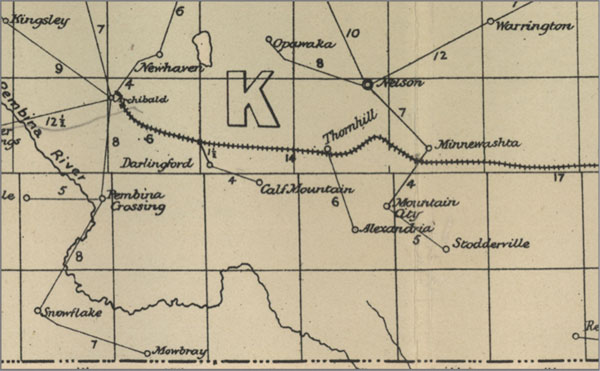
The region in 1884, showing Postal & Stage Rotes. When the Adam Nelson homesteaded in the area north of present day Morden, starting a mill wasn’t part of the plan. Mr. Nelson was one of many who had selected a property sight unseen. When he arrived, he was at first a little concerned by the stands of trees on what he had hoped would be typical open prairie – ready for the plow. So one of his first projects was to build a grist and sawmill on Silver Creek. Mr. Pugh – ran the sawmill. A shingle mill is also mentioned. The village followed, and soon it was a busy place. It was incorporated as a town, now officially named Nelson, in 1882. Choice corner lots were selling for as much as $1000. A substantial brick town hall was erected with rooms for the Land Registry Office, a County Court, and a Council Chamber. A full range of stores and services lined the Main Street. The Dominion Government had virtually promised that the CPR would run through Nelsonville and proceed westward. By 1880 the Nelsons had moved their mill to the rival boomtown Manitoba City. 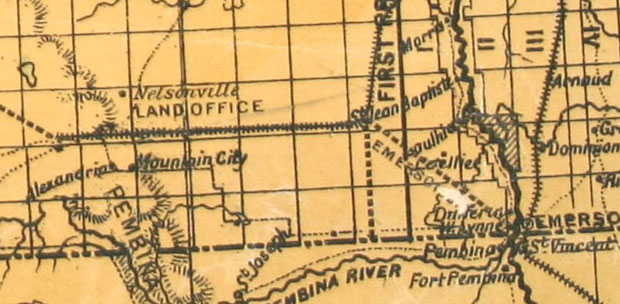 Rival communities, Nelsonville and Mountain City. The Land Office located at Nelsonville is another indication of its importance. In 1879 a second operation was started at Nelsonville. It was built by the Duncan Brothers, and a Mr.Stevenson, under the firm name of the Nelson Milling Co. Mr. Fraser purchased the operation in 1881 and called it the Belmont Mills. By 1883 the press reported that, “having recently re-fitted and improved, (the mills) are now in full blast.” And finally, in January of 1886, we learn that Mr. Nelson’s flour and saw-mill, was burned to the ground. At that time the mills, which were considered old landmarks in Southern Manitoba, were the leading mills of that section of the country and commanded the trade of 100 miles of fair farming country. The insurance amounted to $2,500, and the loss was estimated at $10,000. 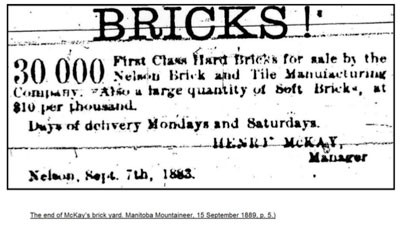 An advertisement in Nelsonville’s Manitoba Mountaineer newspaper of 7 September 1883 advised that the Nelson Brick and Tile Manufacturing Company was offering 30,000 “First Class Hard Bricks” for sale, along with a “large quantity of Soft Bricks, at $10 per thousand.” Mountain City Mountain City, was also vying for the right to be seen as the commercial centre of the region. The Nelson Mills appeared to thrive for a few years. On Dec. 2, 1880, a news report from Mountain City, reported that: “Messrs Nelson and Pugh have to keep their mill running night and day to fill orders and yet cannot supply demand.” In what was to become a familiar story across western Canada, the railway surprised everyone and passed between the two towns and created Morden, in a bare field along Dead Horse Creek. The first two towns in the region just disappeared, their buildings moved or dismantled. 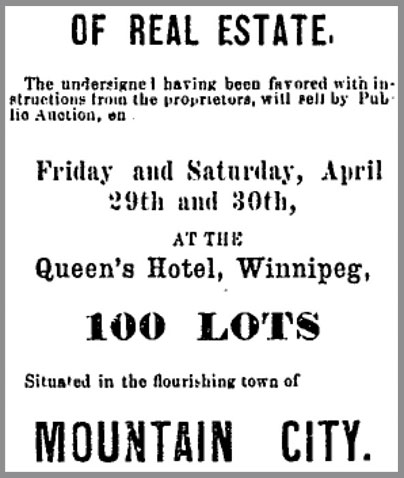 This ad from April 27, 1881 goes on to list the gristmill and sawmill as features of the town. Unlike the many exaggerated claims made for boom towns, these services were indeed available in Mountain City. Press Clips S: MFP, March 2, 1881, p. 1. “Nelsonville News” – “Mr. Fraser, of the late C.P.R. firm of Fraser, Pitblado and Company, has purchased the mill and is coming to reside here at once.” S: Nwfmm, November 1883, p. 277. “The Belmont Mills, at Nelson, owned by James H. Fraser, Esq., having recently been re-fitted and improved, are now in full blast.” S: Nwfmm, January 1886, p. 354. “The Nelson, Manitoba flour and saw-mill, owned by Mr. James Fraser, was burned to the ground lately. The damage was $10,000 with slight insurance. The cause of the fire is unknown, the mill having been shut down nearly twelve hours when the fire was discovered.” The flour mill contained three run of stone and the saw mill had a daily capacity of 10,000 feet of lumber. They were erected by Messrs. Duncan Brothers and Stevenson under the firm name of the Nelson Milling Company in 1879. Mr. Fraser purchased them in 1881, the price paid being about $8,000. The fire was discovered about 5 a.m., but having made considerable headway, resulted in a total loss. The cause of the fire is unknown, but is supposed to have originated in the engine room. The insurance amounted to $2,500 and the loss is estimated at $10,000. Glenora can lay claim to being the first “town” in the RM of Argyle in that there was a half-hearted effort to promote the original site of Glenora by the usual method of selling lots to speculators. The site, unlike the many other wonder towns, did have both some potential and some actual commercial activity. That commercial activity included a sawmill, a store, an implement dealer and a grist mill built in 1882 by Blaine & Reid (SE of 20-3-l3). It was the grist mill that is credited with providing Glenora with its name. It was named after an Ogilvie Co. mill near Montreal that was called Glenora Mill, and produced “Glenora Patent” flour. 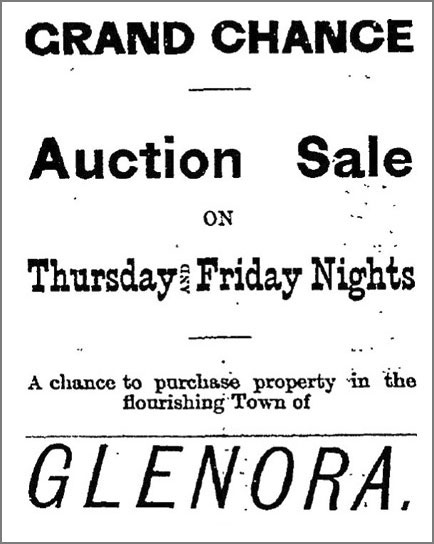 Winnipeg Daily Sun - Sept. 13, 1881  Winnipeg Daily Sun - Dec 3, 1884 Interestingly, although the ad in the Winnipeg Sun from September of 1881 has clearly identified the townsite of Glenora (without giving the exact location!), at least one pioneer recalls that “I never heard any name except “Mill and Store” for that village”. Named or not, it was the commercial centre of the region for a short time and is recalled in several pioneer reminiscences. Alex Rankin from Killarney recalls traveling to Glenora “for grists”. A Clearwater pioneer remembers that the first trip for “grists” was to Glenora. The mill burned in 1885 and it appears that the store may have closed soon after, but the name was well enough established to be resurrected when the railway finally arrived a few kilometers to the northeast. The millstone from that mill has been carefully placed on grounds of St. George’s Anglican Church, in Glenora.  Glenora Press S: Nwfmm, Dec. 1885, p.313. “The Glenora saw and grist mill at Rock Lake, owned by Blain and Co., was burned to the ground at 4 o’clock in the morning of Sunday, 28th Oct. The damage amounts from $8,000 to $10,000 without insurance.” S: Commercial, December 18, 1883. “A new grist mill is being erected at Glenora, by Messrs. Blain and Reeves. It is expected to be in operation in a little over a month.” S: Commercial, May 3, 1887, p. 654. “The settlers in the Glenora district, Turtle Mountain, are agitating for a roller flour mill, and a bonus by-law may be submitted. S: Nwfmm, December 1885, p. 313. “The Glenora saw and grist mill at Rock Lake, owned by Blain and Company, was burned to the ground at 4 o’clock in the morning of Sunday, October 28. The damage amounts to from $8,000 to $10,000 with no insurance The Preston Lime Kiln There were about 12 lime kilns in the region. For years, the Cooper Bros. operated a lime kiln east of the top of Victoria Hill, near Neelin. The most notable was operated by the Preston Brothers and Herman Davis on the steep north shore of Rock Lake not far from Glenora. It started in operated from1893 until 1903 and was one of the largest kilns in Western Manitoba. It was one of two Preston family lime kilns. This one had a 20 bushel capacity. It is one of the best-preserved examples of a lime kiln in the region. 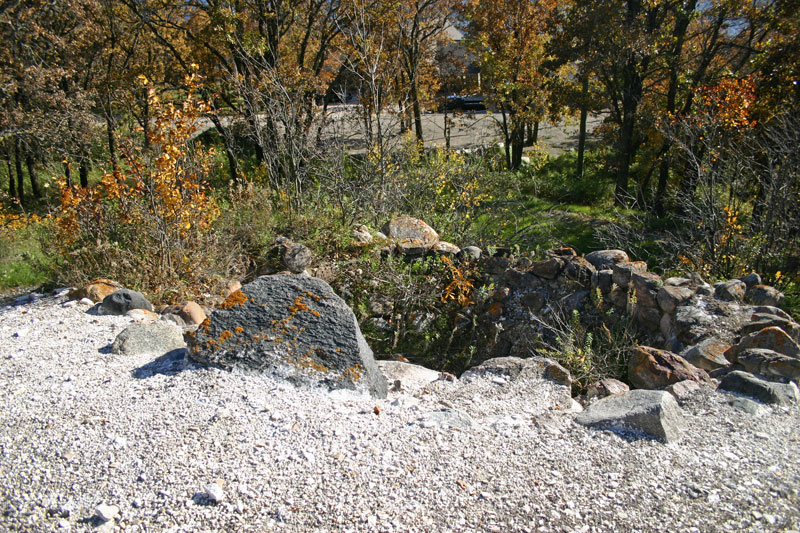 Small kilns are common throughout the region but the Preston kiln was larger than most. 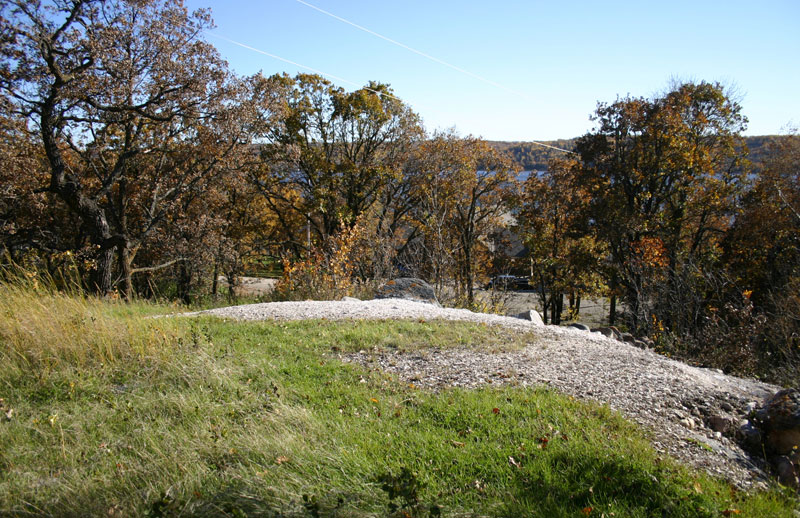 Like many kilns it was located on a slope, allowing access to the bottom level where the fire was tended. Rock Lake is in the background. 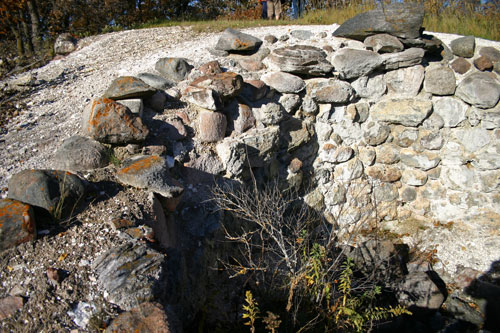 The view from below. A curious elevation of land a bit east of Rock Lake was a reliable landmark for generations of Aboriginal and Metis hunters, Canadian fur traders, and early European settlers who travelled in the Pembina Mountain country. 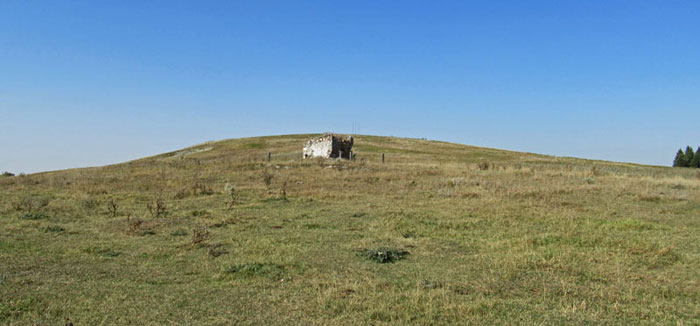 The mound and the vault left behind when buildings were moved to the “new” village of Pilot Mound. There was a lime kiln on the east side of the mound, by the brickyard. It was operated by Mr. Beveridge. Once again the “old” town was replaced with the arrival of the railway. In the early days of the new town, George White operated a grist mill and McDonald and Band built another mill. This last one was sold to Dow and Will, and burned down. In 1893 “Great West Oatmeal Mills” was built by George Dow and Adam Curry. A large building was erected and it was a quite a success for some time. They shipped their product far and wide, including to Britain. 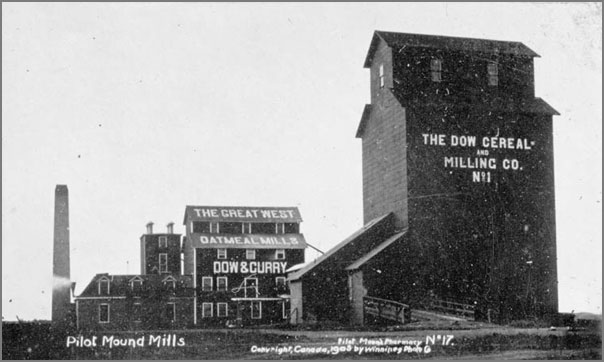 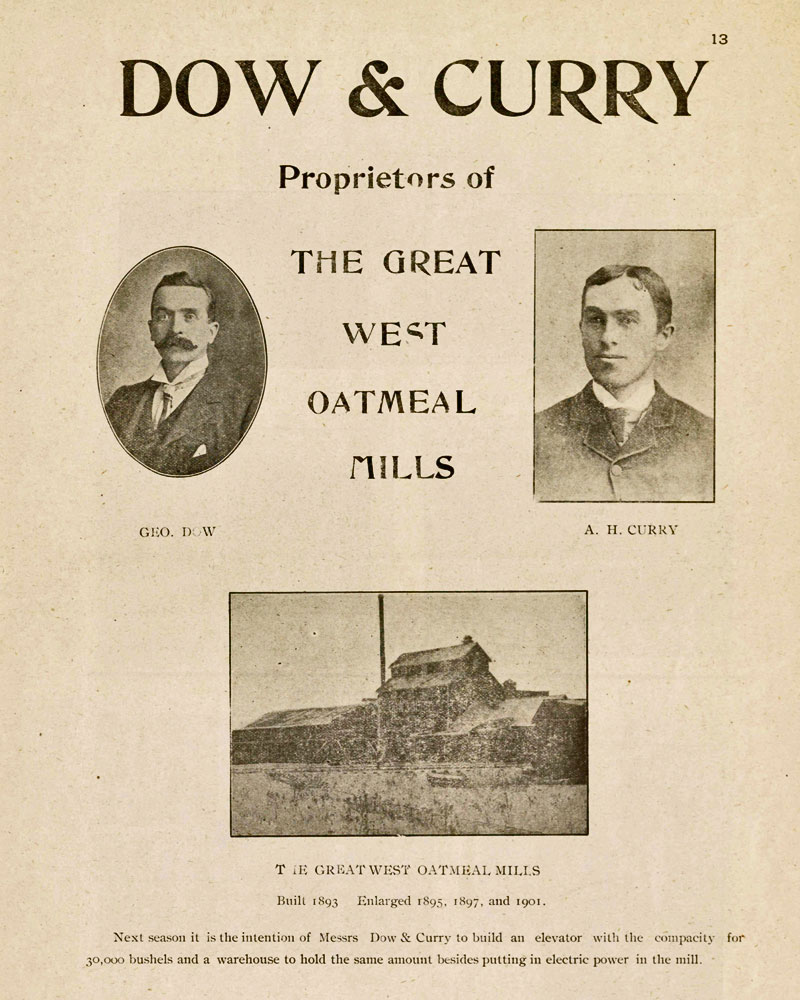 Press Clips S: CH, Memories of Pioneer days at Pilot Mound, William Reid, 1903, p. 15. “A flour and grist mill was built on the banks of the creek by T.P. and Ben White.” – c.1882. S: Nwfmm, May 1889, p. 133. “T. McKay, J.B. Barid, Jno. Hiebert, W.A. Donald, Jno. M. Fraser, Jno. Knox, W. Carson, J.B. Gordon and W.C. burns, of Pilot Mound, Manitoba, are applying for incorporation as the Pilot Mound Milling Company, with power to carry on at Pilot Mound and elsewhere in Manitoba, a milling, flour, grain and elevating business. Capital $16,000. An American firm offer to supply the company with machinery for a roller four mill. The price asked is $7,327. In addition the engine will cost $1,575, without boilers. The mill to be 75 barrel capacity. Another firm at Minneapolis offer to provide all the machinery required, including engine, for $10,000. S: Nwfmm, July 1889, p. 187. “Letters patent have been issued incorporating T. McKay, [et al.], as the Pilot Mound Milling Company Limited. Capital $16,000.” - “The new roller process flour mill at Pilot Mound, will leave the old one unused for making flour, and as there are the building, stones and machinery “ S: Nwfm, January 1890, p. 372. “A public meeting was recently held at Pilot Mound, Manitoba to consider the proposal of Mr. Messner to move the St. Leon mills there. It was stated the buildings and machinery would be moved to Pilot Mound if farmers would assist with their teams in the removal. A bonus of $1,000 would also be required. The well and ground owned by the Pilot Mound Milling Company would be taken as part of the bonus. The establishment consists of a stone flour mill, a barley and oatmeal mill.” S: Nwfm, April 1890, p. 461. “Pilot Mound was one of the earliest places in the province to have a grist mill, and has always been a first rate centre for such a business. The mill from the old town was moved over among other buildings when the new town was started, but was behind the requirements of the times, and business difficulties prevented its being successfully operated. At last Mr. Frazer, the pioneer of the settlement, made an arrangement with Mr. Whitelaw, of Woodstock, Ontario, to move his flour mill from Darlingford and the oatmeal mill from St. Leon, to be located on the site provided by the joint stock company last year. Besides giving a site and well free, the town gives $500 bonus when the machinery is laid down, $500 more when the mill is completed, and $700 more in March, 1891. The roller mill will make over 60 barrels of flour a day, and the oatmeal mill will have the same capacity. Stones for chopping will also be put in, and as fuel is reasonably low and the district well settled a first-rate business may be relied on . Farmers have been busy hauling the oatmeal mill machinery from St. Leon, a distance of 25 miles, and the work will be pushed rapidly to completion.” S: Nwfm, June 1890, p. 522. “R. Whitelaw of Woodstock, Ontario is having plans prepared for the new mill which he will erect this year at Pilot Mound, Manitoba.” S: Nwfm, October 1890, p. 639. “The new engine and other machinery for the Pilot Mound, Manitoba flour and oatmeal mills has arrived. Millwrights from Ontario are placing it in position.” 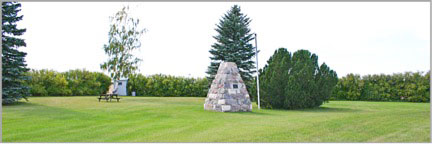 A Cairn marks the general locality of Wakopa The first entrepreneur in the Turtle Mountain district was a fur trader, Bernard B La Rivière. He settled in Nelsonville, a would-be boom town, that quickly disappeared when Morden was established. On a hunting trip to Turtle Mountain in 1876, he saw an opportunity. The Red River valley was already dotted with farming communities. Everyone knew that European settlers would be pushing westward soon. Treaties were being signed and railways were being planned. Homestead regulations were being formulated. He decided to be ahead of the crowd, to have a stopping place and store up and running for when the trickle of traders, surveyors, and travellers already venturing westward gave way to a steady stream of homesteaders. There would be many of them and they would need supplies. Just as a would-be gas station owner in later times would prefer to be on a highway, La Rivière had the same plan. The Boundary Commission Trail was the highway. He selected a spot on the Long River, just east of the slope of Turtle Mountain, a spot once used by Assiniboine hunters as a camping place. They were quickly followed by the Harrison Brothers and Mr. Williams who built a sawmill and gristmill powered by water wheels and using grinding stones brought from France. Soon the first sod and log homes gave way to buildings of milled lumber. The first frame house in the Turtle Mountain area was built in 1880 The development of the grain business began in Wakopa long before the railway was built through Boissevain and Killarney. In 1878 Matthew Harrison built saw and flour mills in the new village. The mill was powered by a water wheel on the banks of Long River. George Bennett brought the first gristmill stones to Wakopa, imported from France. A water wheel also powered the family sawmill. To accommodate the settlers who brought their wheat from afar by oxen to be ground into flour, the family built a boarding house and large livery barn. These businesses, along with B.B. Lariviere’s Store and Stopping Place established Wakopa as an important place. People came to Wakopa, bringing grain to be ground into flour, or buying lumber at the sawmill. Meals were served at the Harrison home, at La Riviere’s, and at Mrs. J. Melville’s boarding house.  Winnipeg Daily Sun, April 28, 1884 On the second floor of that historic building one can still see the rough cut 2 by 6’s that were sawn at the old Wakopa for the Harrison’s next enterprise. And a visitor to the Turtle Mountain Flywheel Clun Museum in Killarney can see the machinery from the original Wakopa gristmill on display. Mill stones are in various places. One is in the Cairn at Wakopa and one is in the museum in Boissevain. Cheese Factory John Hettle formed a company in 1885, of which T. A. Sharpe and the Young brothers were directors, to operate a steam-powered butter and cheese factory on Sharpe's Creek on NE 26-1-19. Later the herd had to be destroyed because of disease and the factory was dismantled. Press Clips S: Nwfmm, August 1883, p. 218. "It is estimated that the loss by the burning of the mills at Wakopa will amount to at least $8,000." S: Nwfmm, May 1887, p. 838. "William Harrison, proprietor of the grist mills at Wakopa, Manitoba, will put in roller process machinery." The Boundary Commission Trail crossed the Pembina River in a broad valley south of present day Manitou. Crossings were often likely spots to establish a Stopping Place and other services. As always, good crossings on the Boundary Trail were not necessarily chosen by the railway.  Pembina Crossing, south of Manitou (no date) Source: Ed Grassick This item from the media at the time sums up the vitality of the community in 1882. “Pembina Crossing 1882. (From the Manitoba Mountaineer, Nelsonville, Manitoba) This city is known as the Pembina Crossing and this is written at the Pioneer's Rest, and William P. Hutchinson, proprietor - a first class host who boasts a billiard table, a sample room, a new organ and organist, with lots of good singing every night, a splendid bill of fare, and all for $4.00 per week. Ten regular boarders, besides his own family and hired help. Is furnishing wood for grist mill that is running here. It is grinding for fifteen cents per bushel. Take that, ye extortionists. The town boasts a general store, post office, a blacksmith shop, two hotels. William and his sister, Jeannette, established a Stopping Place and a butcher shop at Pembina Crossing in the early 1880's for the benefit of the homesteaders who were using that route to enter Canada from the United States. Some other press clipping from the era provide additional details… June 2, 1881. The Queen's birthday (May 24) was royally celebrated here by a large assembly in the following manner: foot races, horse race, pony race, a lively game of baseball was much enjoyed by the boys. We were also glad to see a grand turnout of the much- needed sex in Manitoba. (Emerson International.) "Mr. H. H. Black, a dentist by profession, arrived in the Pembina Crossing district from Emerson by team, in June 1880. He had married in Halifax, NS, and afterwards traveled through the United States as far as Colorado. His father (George C.) and his elder brother (George) lived in Winnipeg. H. H. Black did not wish to be a dentist and he loved "the outdoors." Therefore he took up a homestead (SEI/4 24-2-9W), but due to an injured foot, Mr. Black was unable to carry on with farming.  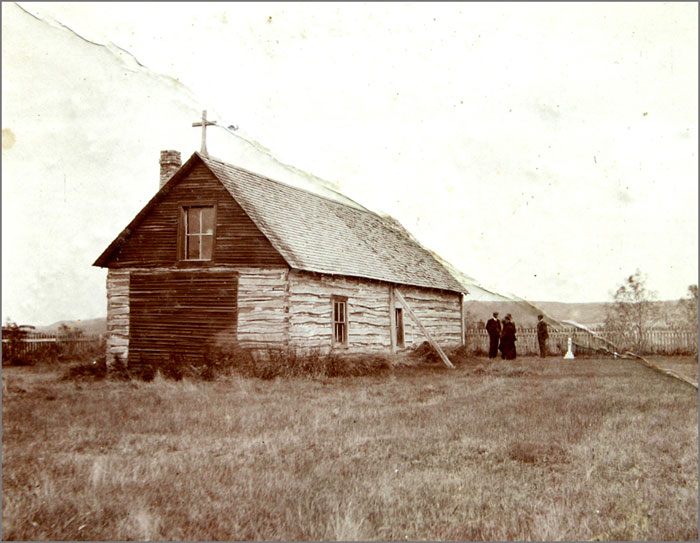 Old St. Luke’s Pembina Crossing Anglican Church (Archives of Manitoba) Originally a general store, post office, and saloon, built in May 1880, this log building was in use until 1920 when it was replaced by a new building, which opened on 26 September 1920. The following year, by an unfortunate accident, it burned down although most of the furniture and fittings were saved. In 1922, it was replaced by the present structure, a municipally-designated historic site as of 2011.  St. Luke’s Pembina Crossing Anglican Church (August 2018) Source: George Penner 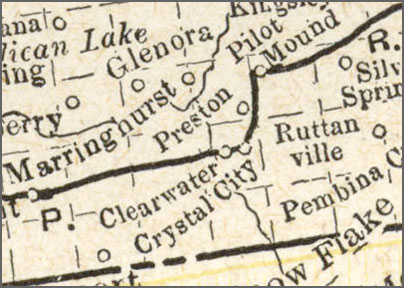 At the time this map was drawn in the early 1890’s, Neelin (near the site of Roseberry) was not yet created, an Glenora was just a Post Office south of where the town would be located. Clearwater The village of Clearwater existed for nearly five years in the valley below where the current village sits, and only had to move a short distance to be on the line. It was a busy little place with a few stores, a boarding house and a hotel. There was a blacksmith, a tailor, a shoemaker, and a doctor. William Coulthard and his brothers John and Tom came to “Old” Clearwater in 1881, and built a gristmill on the river. Locals report that it made “very fair flour, but if the wheat was badly frozen it was out of the question to get good bread from the flour.” There are very few other mentions of this mill, but one press report indicates that it was being upgraded in 1893. Proximity to other towns may have made it unnecessary. Neelin Mill machinery was valuable. When one closed the machinery was generally moved elsewhere. The short-lived Pembina Crossing mill was given a new life in Neelin, at the western edge of Rock Lake. Watson and Cowie, set up both a sawmill and a gristmill in the valley, using water power from a fast flowing spring. By damming up the spring in the evening, there was enough power to run the mill all the next day. Eventually this mill was changed to steam power, and the spring just used to wash away the sawdust. The mills were destroyed by a prairie fire. There are two reports as to just when that happened. One says, this mill, along with the other two in the valley, was destroyed in the big prairie fire of 1886. Another report offers different details…”In 1893, a prairie fire swept through and left devastation in its wake. It was not checked until it had reached J. Brinkworths. Trees, logs for buildings, game and stock were not spared. It burned the Cowie and Watson Grist and Sawmill. They did not rebuild.“ Prairie fires were common, sometimes with tragic results, but generally property damage was the main concern. John Montague had two sawmills, one on the Neelin farm and one at Kelly's creek. Lime Kiln The Cooper Bros. operated a lime kiln east of the top of Victoria Hill. Roseberry Lime Kiln was on the W.W. Sexsmith farm at 2-4-14. Bricks Mr. Rossom and W.W. Sexsmith made some sample bricks at the Roseberry Lime Kiln on the Sexsmith farm (2-4-14) intending to produce if orders were places. Cheese Factory William Coutts , who homesteaded about three kilometres north of Neelin ( 36-3-15) was a outstanding teacher, and also deeply interested in the affairs of the community. Largely through his efforts a cheese factory was established which operated successfully in the district for several years. Preston On several maps from the 1880’s one finds Preston, west of Pilot Mound. In 1879 a saw and grist mill was built by James Preston on 13-3-12, a store too was built at this location. The machinery for the mill was brought from Ontario and freighted from Emerson in 1879 by neighbours with horses and oxen. A short article in the Winnipeg Free Press in the winter of 1880 commented: “in Preston which takes its name from three families who moved in there one year ago. Being enterprising businessmen. they already have a sawmill in operation, and are making active preparations for a grist mill. They are offering free building sites to business men and mechanics who will become permanent settlers. “ Lumber from the Preston sawmill was used in the first church west of the Pembina at Crystal City in 1879. 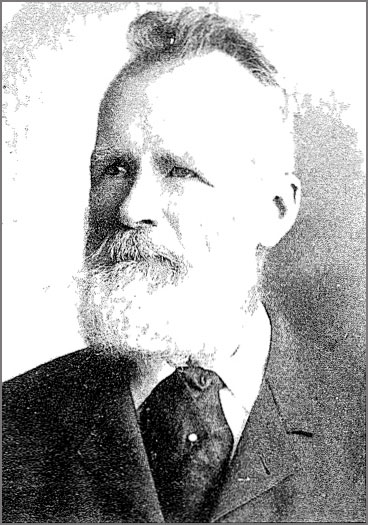 R.S. Preston During 1881 the mills were burned down. The sawmill was later rebuilt in the valley, but only operated for a short time as Mr. Preston had the misfortune of having his arm cut off by the saw.  A plaque at the site of Goudney School (SE 14-3-12) reads. 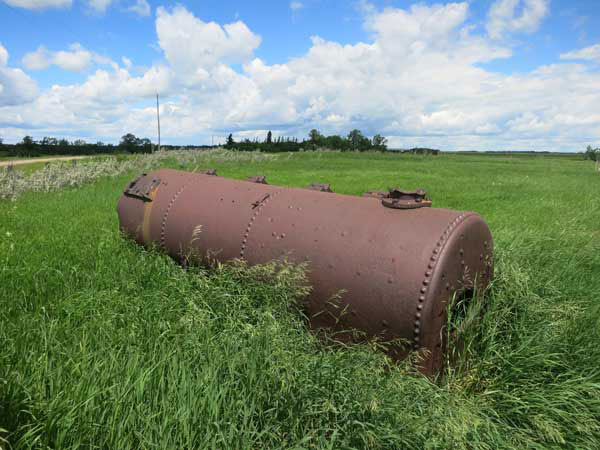 “This steam boiler is the only remaining artifact of the sawmill that was built by James B. Preston on the creek a short distance west from the bridge, ¼ mile north of this site. The sawmill operated from 1879 – till destroyed by fire in 1881 and supplied lumber for much of the first construction in the area. Placed her by Goudney Memorial Committee A.D. 1980.” Press Clips S: AM, March 1, 1884, p. 137. “Watson and Cowie are establishing a mill at the head of Rock Lake, Manitoba, the machinery for which is brought from the grist mill at Pembina Crossing, which is now dismantled.” People these days tend to forget the extent to which things were manufactured locally. Perhaps this is because we are so far removed from the site of the production of many of the goods we consume that we haven’t thought about how the process isn’t always difficult to create on a small scale.
Crystal City, as the name implies, was created by optimists. It was, in a sense a planned community, established by Thomas Greenway who toured the region in 1878 and returned with settlers the following year. It was the site of the first registered Church building west of Emerson. It would naturally have been the site of a flour mill. Although local history volumes offer scant details about the mill. We do find mention tha the son of Thomas Greenway worked in the Rolling Mill in town. Another report has a flour mill “south of the elevators” that burned down. The press however offers a sort of timeline of events - the outline of the story. From it one sees a familiar pattern. Ownership changes were routine. Moving and starting elsewhere was common. Press Clips S: Nwfmm, November 1883, p. 299. “Crystal City mills commenced operations on the first of this month.” S: Nwfmm, February 1884, p. ____. “The Louise municipal council at their recent meeting, held at Rock Lake, decided to relieve the grist mill at Crystal City, and Clearwater, from paying taxes.” S: AM, June 1, 1885, p. 302. “The grist mill at Crystal City, Manitoba is to be moved to Snowflake, Manitoba.” S: Nwfmm, June 1888, p. ____. “I have just finished changing a mill from burrs to roles for Cochrane and Manson, Crystal City, Manitoba on the short system of three reductions of wheat and three on middlings – Millwright.” S: Nwfmm, April 1889, p. 100. “Mr. Crawford, of the Crystal City, Manitoba mill, will build another one at the station, larger than the one he owns at the old town site. A bonus in wheat, to be delivered next fall, is offered him.” S: Nwfm, December 1889, p. 340. “The roller mill at Crystal City, Manitoba is now running.” S: The Commercial, 1893, p. 634. - Owner J.W. Cochrane with 125 barrel capacity per day. Cheese Factory Alexander Taylor managed a cheese factory at Crystal City. Some ads placed in a promotional publication in about 1911 remind us the custom made clothing was an option in Crystal City, a sort of manufacturing on a small scale. Promoting Industrial Growth Crystal City was probably not alone in actively seeking out manufacturers. The ad offers a perspective on what a “progressive” town would see as important. |
